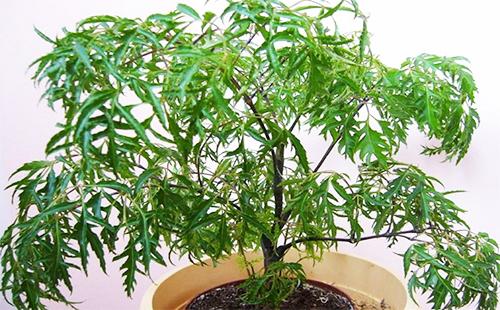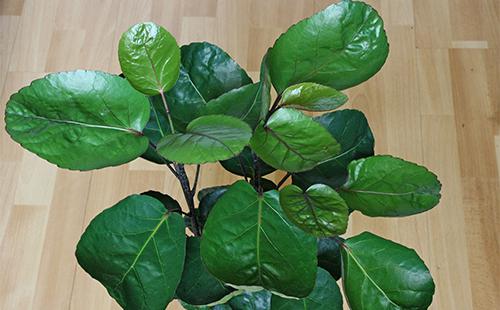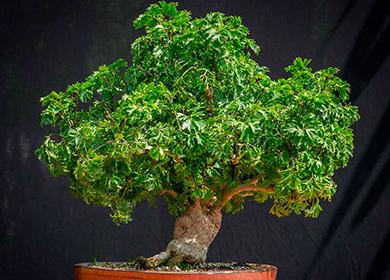The content of the article
Poliscias belongs to the Araliev family and has about 80 species. Tropic forests of Asia and the Pacific coast are considered its homeland. In our country, he took root as a houseplant, which is very capricious in care.
Species diversity
Only some polysacias are suitable for indoor cultivation. Flowerpots with decorative trees and bushes are placed in apartments and offices. Most often for indoor gardening, the following types are used.
- Shrub (fruticosis). Outwardly very much like a fern. Its numerous shoots are strewn with twigs with shiny cirrus leaves with small serrations, each of which has a different cross section and shape.
- Paniculate. This is a short shrub with large cirrus and dissected leaves. Their color can be monophonic bright green, and with white stripes or spots.
- Tupolistny. The leaves of this shrub look like oak. They are three-bladed and rounded. Their color is green or grayish.
- Helmet-shaped. Its main trunk is thickened and curved, and the branches are straight. Young dark green leaves are round. Over time, their shape changes, and a light border forms at the edges.
- Guilfoyle. Can grow very tall. The leaves are large pinnate and dissected, with a beautiful carved edge and a white or light yellow border.
- Balfour Low shrub with a significant number of branches. Leaves are large and rounded. Along the edges - an uneven white edging. There are varieties with marble spots and stripes along the veins.
Basic care
If the plant is created comfortable conditions, it will respond with abundant growth. And any discrepancies will immediately affect the appearance. Experienced flower growers are advised to adhere to the following recommendations.
- Lighting. The plant loves diffused light without direct sunlight. It is better to place it near the windows on the east or west sides of the room. For varieties with monophonic leaves, a small partial shade is acceptable, and variegated coloring requires bright lighting. In winter, the flower will not do without phytolamps, since it will tolerate very little daylight savings.
- Temperature. We need to try to maintain the same temperature regime throughout the year. Ideally, 20 ° C. In the cold season, a slight decrease in temperature is acceptable (by two to three units). But at the same time, the flowerpot should not stand near the radiator or fireplace, so that the streams of warm air do not overheat the foliage and roots. It is necessary to protect the plant from drafts.
- Moisturizing. In this matter, the tropical guest is also demanding. It does not tolerate dry air, so there should always be a container of water near the flowerpot. He will respond positively to daily spraying and periodic warm showers.
- Watering. Often you should not water poliscias. The topsoil must have time to dry before it needs to be moistened again. This is especially important to observe in the cold season.
- Fertilizer. In spring and summer, poliscias is growing rapidly. To give strength, the plant needs to be fed. As fertilizer, ready-made complex mixtures are suitable, which must be applied twice a month. In other periods, it is better not to disturb the plant.

Transfer
In order for the plant to grow and develop well, it is necessary to periodically change the soil and flowerpot. It is best to transplant poliscias in the spring. Young cultures - once every 12 months, older individuals - once every 24 or 36. To do this correctly, you must:
- pick a pot - its size directly affects the growth of the plant (if the roots in it are spacious, then the shoots will stretch as far as possible);
- choose substrate- you can buy a ready-made "universal" or make it yourself by mixing in equal parts sod-leaved land, humus, peat and sand.
The flower is transplanted by transshipment. Poliscias must be carefully removed from the old flowerpot with the soil. To remove the old earth from the sides, without touching the root system. Pour drainage (broken brick or expanded clay) to the bottom of an empty pot. Lay a thin layer of a suitable substrate on top. Put the plant along with the remains of the old soil in a pot. Add fresh to full volume. To water.
Crown formation
Poliscias refers to plants whose crown can be adjusted to your liking. To stimulate the emergence of new buds, the "extra" branches can be trimmed. This is best done in the spring, when the plant begins an active period of vegetation. If the appearance of the flower is satisfactory, pruning is not necessary. You can limit yourself to pinching the tips of individual shoots.
Breeding
The best time for this is spring. In the arsenal of gardeners, there are two options for the propagation of poliscias.
- The separation of the bush. Poliscias can be planted during the next change of soil. For this, a daughter is separated from the mother bush, focusing on the development of its root system. And transplanted into a separate container.
- The use of cuttings. This method is more complex and painstaking, since the "capricious" branches are in no hurry to take root. It is necessary to process the trimmed part with activated carbon and air dry. Then put in a well-moistened mixture of sand and peat. And to get a greenhouse, cover with a glass jar or a transparent plastic bag. If everything is done correctly, in a month the plant will take root. After rooting, young individuals do not differ in any requirements from adults.
Actions after the purchase
If independent attempts to propagate the culture failed, you can go to the flower shop and choose your favorite plant. So that a new pet does not disappoint, when buying, you need to focus on its proportion. A handsome, full-leaved man cannot be sold in a small pot, since the roots of the “right” flower always correspond to the crown.
You need to take care of a newcomer in the same way as for his "relatives" who are already in your house. The only thing that can be done right away is to transplant the plant into a suitable pot, if necessary.

Growing difficulties
For all its “capriciousness," pests rarely infect pests such as scale shield, mealybug or aphids. This is because the plant is poisonous. Nevertheless, if some bugs appeared on a flower, it is better to treat it with an antiseptic or insecticide.
The main diseases of the plant are associated with errors in care, so their treatment does not require the use of special drugs.
- The crown crumbled. Poliscias resets leaves in response to any discomfort. Stress for it can be an overabundance or lack of moisture, a climate change and a rearrangement of the pot.
- The foliage turned brown. The reason is very dry air.
- Gray rot appeared. The flower is frozen - it is overcome by drafts or the water for watering is too cold.
By eliminating the root cause, you can return the plant a luxurious, healthy look.

